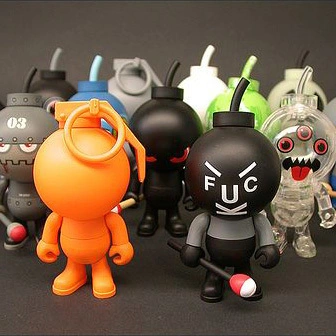Vinyl Toy
Until now, many people think that vinyl is the name of a material. Here, it is necessary to popularize the science. In fact, vinyl is the name of a manufacturing process (rotocasting process). Due to the special manufacturing process, some other things are added to the material. As a result, people feel that it feels different from ordinary PVC toys, and they mistakenly believe that vinyl is the name of the material.
The “vinyl process” involves layering copper (possibly other metals, though the specifics are currently unknown) onto the surface of the prototype. This copper layer forms a basic metal mold. Then, a PVC paste resin (or PVC pellets) undergoes various processes to adjust its softness and hardness, forming a latex-like state. This mixture is poured into the prepared metal mold, which is heated over a flame while continuously rotated to ensure even heating. Afterward, it is removed from heat, allowed to cool, and the mold is opened to extract the product. Generally, this process specializes in producing hollow molded products. As it employs a paste-like PVC resin, which is finer than ordinary PVC resin, the sensation and texture vary for each individual. Compared to regular metal molds, this method is cost-effective and easy to produce. However, its drawback lies in the lack of pressure during the process, and the low flowability of the paste PVC, restricting the production of highly intricate and complex products.
The “vinyl process” uses PVC as raw material, and there are also two types of hard vinyl and soft vinyl(also call sofubi).
Sofubi is the transliteration of "ソフトビニール" in Japanese, which is soft vinyl, also known as soft vinyl and Japanese soft vinyl.
"Vinyl Process" Overview
The process involves pouring a paste-like PVC solution into a mold and sealing it. The mold is then placed in a high-temperature rotocasting oven and rotated slowly along two perpendicular axes. This allows the molten plastic material to uniformly coat the inner walls of the mold under the influence of gravity. After cooling, the mold is opened, and the finished product is pulled out.
Because it takes shape within a rotating mold, "rotocasting," also known as "rotational molding," is a form of rotational molding process.
"Sofubi Production Process" Overview
It can be seen that the difference between Sofubi craftsmanship and regular rotocasting lies in the process of heating and curing. Moreover, the quality of rotocast toys (vinyl toys) largely depends on the precise control of time and heat during these steps.
Vinyl Toys production heavily relies on molds. The molding process of soft vinyl requires high temperatures, hence the use of metal molds, typically made of copper.
With the popularity of 3D printing technology, many designer toys today are designed using computer modeling and then directly 3D printed into master molds. However, in traditional soft vinyl manufacturing, creating master molds is far more complex, usually involving two steps: the clay sample and the wax sample.
The first is a clay sample (sculpture), and the design prototype is carved out manually and machine-wise.
Then there is the wax sample. According to the shape of the clay sample, the corresponding wax sample is carved out. Since the subsequent mold turning process will produce about 3% shrinkage, the size of the wax sample must be enlarged accordingly based on the expected finished product size.
Why use wax samples?
On one hand, the surface of wax samples is easy to polish, resulting in a very smooth surface for the molds produced. On the other hand, the following steps closely resemble the "lost wax method" used in ancient China for casting bronze artifacts.
The wax sample is placed in an electroplating tank, where a copper mold is poured through the electrolytic reaction of electroplating. Then, it is heated to melt the wax into a liquid state. After the wax liquid drains away, what remains is a hollow copper mold, a negative of the wax sample. This copper mold is called the "master mold."
In large-scale production, even metal molds face wear and tear and may become unusable. Therefore, multiple production molds are usually created from the master mold. These production molds are welded onto a steel frame, allowing for subsequent mass production processes.
Characteristics and Disadvantages of Vinyl Toys
Do you still remember the major issue with injection molding—the parting line? Sofubi completely eliminates this headache. Because the mold is a single-piece formation, it ensures that the finished product has no parting lines.
Furthermore, due to the centrifugal force from rotation, sofubi toys are generally hollow. They are lightweight, have a bouncy feel, are less prone to damage from falls, and are convenient for playing with, carrying around, and using in outdoor scenes. Beyond merely sitting in collectors' display cases, they offer more companionship and social interaction. Perhaps this is why many designer toy brands are increasingly adopting vinyl process to customize art toys.
What are its manufacturing flaws?
First, vinyl toys have design limitations. If a toy has many sharp protrusions or indentations on its surface, the flow of the liquid rubber material within the mold will inevitably be obstructed, leading to defects like air bubbles and incomplete fillings. That's why most vinyl toys we see tend to have simple shapes, with rounded edges and no sharp angles.
Secondly, almost every stage of production requires manual labor (except for the copper mold electroplating process). For instance, controlling the molding time, manually extracting toy parts from the mold after forming, and because the shapes of soft vinyl toys vary significantly in finished products, it's not feasible to automate painting in bulk, necessitating manual coloring. Consequently, there's considerable uncertainty in the final products, leading to a high rate of scrap and significantly increased labor costs in production.
Vinyl Craftsmanship Step
Here are some popular types of vinyl toys
Each type of vinyl toy offers a distinct appeal and attracts a specific group of collectors, contributing to the diversity and excitement within the collecting market.














